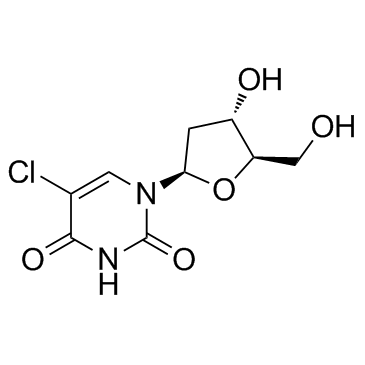5-Chloro-2'-deoxyuridine

5-Chloro-2'-deoxyuridine structure
|
Common Name | 5-Chloro-2'-deoxyuridine | ||
|---|---|---|---|---|
| CAS Number | 50-90-8 | Molecular Weight | 262.64700 | |
| Density | 1.67 g/cm3 | Boiling Point | N/A | |
| Molecular Formula | C9H11ClN2O5 | Melting Point | 176-179ºC | |
| MSDS | Chinese USA | Flash Point | N/A | |
| Symbol |


GHS07, GHS08 |
Signal Word | Warning | |
|
RAD50 phosphorylation promotes ATR downstream signaling and DNA restart following replication stress.
Hum. Mol. Genet. 23(16) , 4232-48, (2014) The MRE11/RAD50/NBN (MRN) complex plays a key role in detecting DNA double-strand breaks, recruiting and activating ataxia-telangiectasia mutated and in processing the breaks. Members of this complex also act as adaptor molecules for downstream signaling to t... |
|
|
Both high-fidelity replicative and low-fidelity Y-family polymerases are involved in DNA rereplication.
Mol. Cell. Biol. 35(4) , 699-715, (2015) DNA rereplication is a major form of aberrant replication that causes genomic instabilities, such as gene amplification. However, little is known about which DNA polymerases are involved in the process. Here, we report that low-fidelity Y-family polymerases (... |
|
|
Role of the Exocyst Complex Component Sec6/8 in Genomic Stability.
Mol. Cell. Biol. 35 , 3633-45, (2015) The exocyst is a heterooctomeric complex well appreciated for its role in the dynamic assembly of specialized membrane domains. Accumulating evidence indicates that this macromolecular machine also serves as a physical platform that coordinates regulatory cas... |
|
|
Checkpoint Activation of an Unconventional DNA Replication Program in Tetrahymena.
PLoS Genet. 11 , e1005405, (2015) The intra-S phase checkpoint kinase of metazoa and yeast, ATR/MEC1, protects chromosomes from DNA damage and replication stress by phosphorylating subunits of the replicative helicase, MCM2-7. Here we describe an unprecedented ATR-dependent pathway in Tetrahy... |
|
|
H3K4me3 demethylation by the histone demethylase KDM5C/JARID1C promotes DNA replication origin firing.
Nucleic Acids Res. 43(5) , 2560-74, (2015) DNA replication is a tightly regulated process that initiates from multiple replication origins and leads to the faithful transmission of the genetic material. For proper DNA replication, the chromatin surrounding origins needs to be remodeled. However, remar... |
|
|
Single molecule analysis of Trypanosoma brucei DNA replication dynamics.
Nucleic Acids Res. 43(5) , 2655-65, (2015) Eukaryotic genome duplication relies on origins of replication, distributed over multiple chromosomes, to initiate DNA replication. A recent genome-wide analysis of Trypanosoma brucei, the etiological agent of sleeping sickness, localized its replication orig... |
|
|
ING5 suppresses proliferation, apoptosis, migration and invasion, and induces autophagy and differentiation of gastric cancer cells: a good marker for carcinogenesis and subsequent progression.
Oncotarget 6 , 19552-79, (2015) Here, we found that ING5 overexpression increased autophagy, differentiation, and decreased proliferation, apoptosis, migration, invasion and lamellipodia formation in gastric cancer cells, while ING5 knockdown had the opposite effects. In SGC-7901 transfecta... |
|
|
Folate levels modulate oncogene-induced replication stress and tumorigenicity.
EMBO Mol. Med. 7 , 1138-52, (2015) Chromosomal instability in early cancer stages is caused by replication stress. One mechanism by which oncogene expression induces replication stress is to drive cell proliferation with insufficient nucleotide levels. Cancer development is driven by alteratio... |
|
|
ATR inhibitors VE-821 and VX-970 sensitize cancer cells to topoisomerase i inhibitors by disabling DNA replication initiation and fork elongation responses.
Cancer Res. 74(23) , 6968-79, (2014) Camptothecin and its derivatives, topotecan and irinotecan, are specific topoisomerase I (Top1) inhibitors and potent anticancer drugs killing cancer cells by producing replication-associated DNA double-strand breaks, and the indenoisoquinoline LMP-400 (indot... |
|
|
Cis-acting DNA sequence at a replication origin promotes repeat expansion to fragile X full mutation.
J. Cell Biol. 206(5) , 599-607, (2014) Fragile X syndrome (FXS) is caused by CGG repeat expansion that leads to FMR1 silencing. Women with a premutation allele are at risk of having a full mutation child with FXS. To investigate the mechanism of repeat expansion, we examined the relationship betwe... |